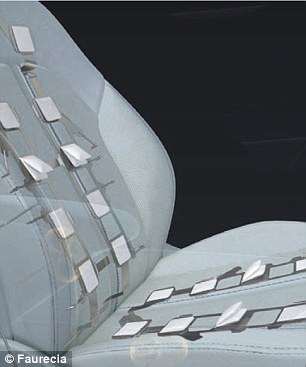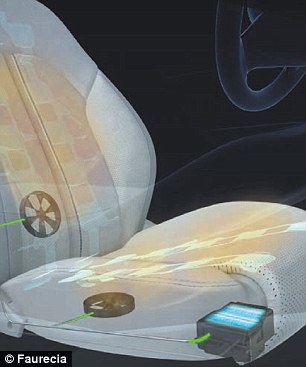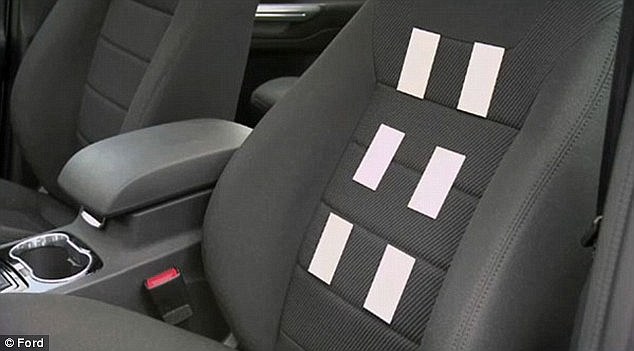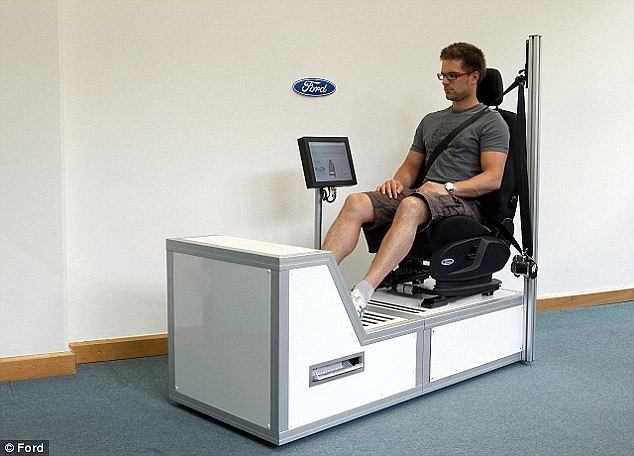

•Faurecia's concept Active Wellness seat has built-in biometric sensors to analyse a driver's heart rhythms and breathing patterns
•Data is used to trigger a massage and blast of warm or cold air
•System is intended to either sooth stressed drivers or wake them up
•Seat, shown at IAA Frankfurt, could be fitted in new cars as soon as 2020
From sitting in traffic jams to speeding along monotonous motorways at night, driving can sometimes be stressful and exhausting.
But keeping calm yet alert behind the wheel could be about to get easier with the advent of a car seat that actively monitors a driver's physical and mental status.
The 'Active Wellness' seat has built-in biometric sensors to detect if a driver is lacking energy or is under stress, caused by road rage or similar.
It then responds by offering a suitable massage and blowing air through its ventilation system.

The 'Active Wellness' seat (pictured) has built-in biometric sensors to detect if a driver is lacking energy or is under stress – and responds by offering a suitable massage and blowing air through its ventilation system
French car seat manufacturer Faurecia claims its concept seat, unveiled at the IAA show in Frankfurt, is a world first.
'What we basically do is to monitor respiration rate and heart rate in the seat, and we derive stress and energy level from that,' Olaf Biedermann, director of innovation at Faurecia said.
'Then, having this kind of wellness being information, we now can offer a closed-loop comfort system; so in case you are stressed you get a relaxation massage, in case you have low energy levels you get a very energising massage.'
The seat has taken five years to develop and the team's aim was to make drivers feel better after their journey than when they set off.


French car seat manufacturer Faurecia claims its concept seat, unveiled at the IAA show in Frankfurt, is a world first. Sensors in the seat (illustrated left) detect a driver's heart rhythms and breathing patterns and the data is used to trigger fans (right) to blow our air and motors to give the driver a massage
They worked with the Spine Research Institute at Ohio State University to come up with tools to measure comfort in real-time, and with engineers at Nasa to improve techniques for collecting a person's vital signs, using sensors that don't touch the skin.
The sensors in the seat are built by American company Hoana Medical and used exclusively by Faurecia.
'We have a unique technology integrated; it is piezoelectric sensors integrated in the seat cushion. Very simple and robust, and our way to measure the information,' Mr Biedermann told Reuters.
By combining these contactless sensors with unique algorithms and signal processing, the team produced a system which they say delivers real-time monitoring of the driver and offering a bespoke treatment.
The team claims despite all the technology in the seat, it doesn't affect comfort, or look noticeable.
The Active Wellness seat senses the occupant's heart rhythms and breathing patterns.
The data collected is used to calculate their mental and physical state, with a message appearing on a dedicated screen, offering treatment.

The sensors in the seat are built by American company Hoana Medical and used exclusively by Faurecia. A diagram showing the functions of the seat including 'fatigue and stress correction' is shown above

The data collected is used to calculate a driver's mental and physical state, with a message appearing on a dedicated screen (illustrated), offering treatment. The screen could be incorporated into a dashboard in future
If the user accepts the recommendation, they will receive a massage with a warming or cooling sensation to either relax or energise them.
The seat is designed to work alongside fitness device, such as the Fitbit, so it can use data collected before the driver got behind the wheel to understand how energised they may be.
The seat could be fitted in new cars from 2020, but no indication of price has been given.
Last year, Ford's European Research and Innovation Centre in Aachen, Germany and Rheinisch-Westfälische Technische Hochschule (RWTH) Aachen University debuted a conceptual seat with six embedded sensors to detect electrical impulses and whether someone is having a heart attack.
The idea is that if higher than usual heart activity is detected, the necessary authorities can be contacted to provide assistance to the driver.

Last year, European Research and Innovation Centre in Aachen in Germany announced it is working on a car seat (pictured) that can detect heart attacks. The device uses six embedded sensors to monitor heart activity. It can then work out through clothing if someone is having a heart attack
The Ford heart rate monitoring seat performs much like a traditional ECG, except the sensors are placed on the surface of the car seat instead of being directly attached to the driver.
The sensors can read the heart's electrical impulses through clothing and are able to use the driver's natural contact with the seat to maintain a reading in most cases.
Research has shown that drivers suffering from cardiovascular disease are 23 per cent more likely to be involved in a road accident, rising to 52 per cent for drivers suffering from angina - chest pains caused by the heart.
Ford's car seat may in some cases detect increased heart activity before the driver notices they are having a heart attack, so the system would display a message to the driver telling them to pull over.
Response teams could also be informed of the heart condition of the driver before, during and after an incident.
Existing Ford systems such as Lane Departure Warning, Lane Keeping Aid, Active City Stop, Driver Alert and Speed Limiter could potentially be activated when the Ford heart rate monitoring seat senses an attack is imminent, mitigating the consequences of a driver losing control because of a heart-related episode.
While the seat is a concept, it could be ready to be fitted in cars in 2020.

The sensors sit on the back of the seat with the electrodes designed to detect the electronic signature of the heart through clothing. The system (shown being tested) will notify the necessary authorities in an emergency. There's no firm roll-out date yet but it should be available by 2020, a Ford spokesperson told MailOnline
Day|Week